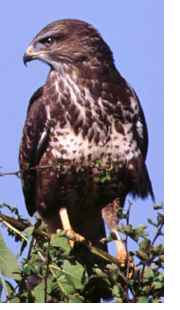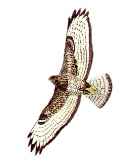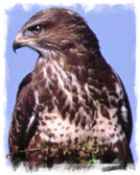| |
|
|
NOVEMBER - BUZZARDS
Relatively rare (certainly in central England) just a few
years ago, the buzzard is now arguably the most common British bird of prey.
Without any special conservation efforts, it has re-established in its traditional
hilly areas, and has travelled south and east across England until the talk
now is of controlling numbers.
RECOGNITION
It is is easily distinguished from all other species of hawk by
its size alone, and we in Barford are very unlikely to see a
golden eagle and mistake it for a buzzard!
It is a large bird with broad,
rounded wings, and a short neck and tail. Its wingspan may vary between
48 inches to 60 inches with a body length
of some 20 inches. Its plumage is a rich brown, with lighter markings
beneath. In flight the wings have a ragged appearance as it glides and soars,
when
it will often hold its wings in a shallow 'V'.
[Back to top]
WHERE TO SEE BUZZARDS
 Buzzards like trees and hilly crags for nesting with open farmland
and moorland nearby to feed over. They are found in their greatest
numbers in hill country, for example in Scotland, Wales and the
Lake District. However, they are also found on farmland with woods and
in more
arable
areas of central southern and eastern England to where it has
spread in recent years. It has even been spotted over central
London. Buzzards like trees and hilly crags for nesting with open farmland
and moorland nearby to feed over. They are found in their greatest
numbers in hill country, for example in Scotland, Wales and the
Lake District. However, they are also found on farmland with woods and
in more
arable
areas of central southern and eastern England to where it has
spread in recent years. It has even been spotted over central
London.
Locally, buzzards are now often to be seen over Sherbourne woods,
the woodland north of Debden Hollow on the road towards Warwick, or quartering the Avon flood plain. Watch
out for
birds soaring over the woods in fine weather, or perched on fence
posts and pylons.
Buzzards pair in the Spring. At this time, several birds may be seen circling in the same area. They nest in mature trees and build large bulky nests from sticks, grass and other materials such as wool. They will also takeover an abandoned crow’s nest. Normally two or three chicks are reared.
The 'mewing' of the buzzard is unmistakable as it soars in the sky, calling
frequently. Wood pigeons and song birds flee at its appearance, yet rarely
do they fall prey to this large hawk. It is often mobbed by rooks, crows
and jackdaws and it seems easily discouraged from hanging around where
it is not wanted.
[Back to top]
WHAT DO THEY EAT
Buzzards live on small mammals, birds and carrion. It is
a slow flier, and has little chance of catching its prey on the move.
So its usual tactic is to perch motionless on a branch of a large tree,
its
markings being excellent camouflage. It is a patient bird, quite content
to sit for hours at a time until a young rabbit, a rat or a mouse happens
to pass below. Then it will swoop down on to its unsuspecting prey.
[Back to top]
NUMBERS INCREASING:
 For many years this bird
was persecuted by gamekeepers who believed that it was detrimental to both
pheasants and partridges.
However, seldom does it bother with game, although if a young bird
happens to wander
near to where it is lying in wait, it won’t miss the opportunity
for lunch. For many years this bird
was persecuted by gamekeepers who believed that it was detrimental to both
pheasants and partridges.
However, seldom does it bother with game, although if a young bird
happens to wander
near to where it is lying in wait, it won’t miss the opportunity
for lunch.
At the moment, buzzards are very much on the increase. However,
just twenty years ago, extinction was feared from the harmful effects
of organochlorine
pesticides, and during the crisis years of myxomatosis when its staple
diet was itself almost wiped out. Today, with tighter pesticide controls,
and as the rabbit population has re-established itself, so has the
buzzard. Latest figures from bird conservation charity the British
Trust for Ornithology
(BTO) indicate a massive 404 percent increase in buzzard numbers in
southeast England since 1994.
With an estimated 120,000 adult buzzards now
breeding in Britain, the species has arguably overtaken both the kestrel
and sparrowhawk as our
commonest bird of prey.
It's a remarkable comeback story, but one that
could almost be too much for the the buzzard’s own good. For while
the return of this broad-winged hawk is welcomed by many, others say numbers
must now be controlled to
protect more vulnerable birds from predation.
[Back to top]
Links and Sources for this feature:
Birds
of Britain website
RSPB website
BTO
website
National
Geographic, buzzards make a comeback
Bird
forum
Buzzard
population
Bura
folk tale
[Back to top]
|
|


